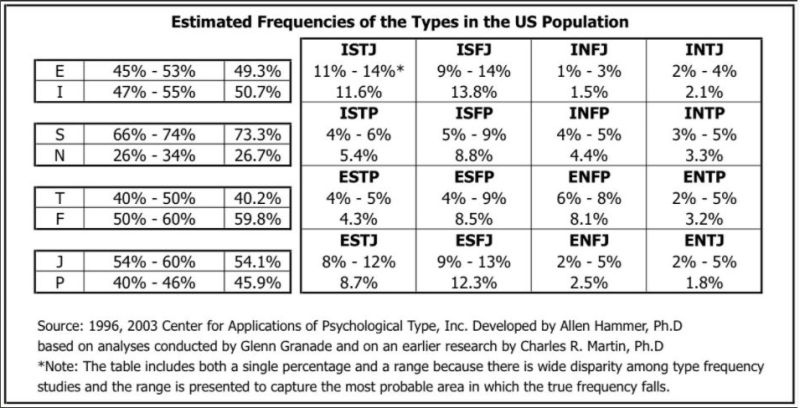The Art of Passing a Personality Test
9. MBTI - Myer Briggs Type Indikator
1. Introduction
MBTI, Myers-Briggs Type Indicator, is a personality test, which is based on the Swiss psychiatrist Carl Jung's type classification of personality.
The test was created around 1945 by Katharine Briggs and her daughter Isabel Myers, who lived in Washington DC in the United States and later in Philadelphia. It is characterized by the fact that it divides personality using four main scales, namely::
- Extravert versus Introvert,
- Sensning versus Intuition,
- Thinking versus Feeling og
- Judging versus Perceiving.
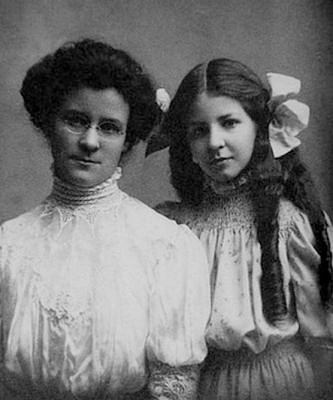
Katharine Briggs og hendes datter Isabel Myers. Photo Wikipedia
The current European version of the MBTI contains 88 forced choice questions, which means that a person must choose one of two possible answers to each question. The choices are a mixture of word pairs and short statements. Test takers may skip questions if they feel they are unable to choose.
The test designers emphasize that MBTI is intended for use for normal people and not for patients with mental health problems. Moreover, all their personality types are equally good and no one is superior to others, they say. Everyone can find their true type and the appropriate place in society. And so store employees and top executives will all be equally happy on their right shelves.
The mother, Katharine Briggs, was an ambitious fiction writer, and it was in this connection that her interest in personality types was born. She wanted to find the basics of personality and behavior so she could create better personal descriptions in her short stories.
In 1923, Carl Jung's book "Psychological Types" was published in English and in it Katharine found the system she was looking for, and she then gave up her own attempts to create a personality theory in favor of studying Jung's work.
Katharine contacted Jung personally, corresponded with him for several years, and met him when he visited the United States. He gave her further notes on experiences from his work in practice, and she consulted with him in the application of his theories.
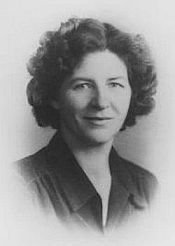
Isabel Myers. Photo Wikipedia
While Katharine was studying personality, her daughter Isabel Myers was busy as a wife and mother. She had two children with her husband, and Isabel enthusiastically threw herself into the task of raising them well. The time she had left, she spent on her own interest in writing. She won a literature prize with her novel "Murder Yet to Come", in which she had used type theory to describe her characters.
With the entry of the United States into WW2, Isabel felt she had a duty to contribute to the war effort, but the usual volunteer activities did not challenge her intellect. She applied for and got a position in a human resources department that used a psychological test called the Humm-Wadsworth Temperament Scale to place employees in a type of work that matched their personality. She learned to score and collected empirical data on its effectiveness, but was disappointed when they showed that the test could not predict job performance in a useful way.
She discussed the issue with her mother, Katharine, who suggested an alternative: to develop a new test based on Jung's theory of personality types, which she had studied for some years.
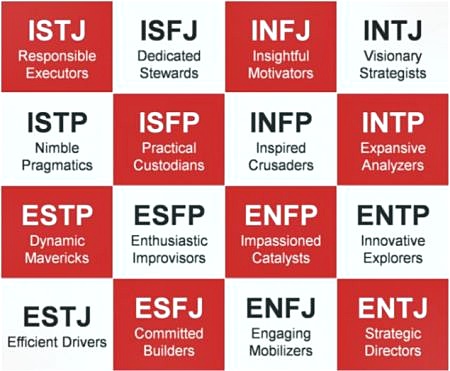
The 16 personality types of the MBTI test. They are easily recognizable on the characteristic four letter code of each type. The types are all described with positive characteristics. Jung's personality types were Katharine Brigg's inspiration, but note below that there are still differences between Jung's type theory and MBTI.
With her children now in college, Isabel Myers now threw herself into the project of creating such a test. She selected 172 questions to be the most effective at sorting test takers into the 16 personality types. These constituted Form A of the "Myers Briggs Type Indicator".
Her breakthrough came around 1950 when MBTI was chosen as the test for new students in the study of medicine at George Washington University. Over the next few years, the test was used by thousands of medical students, creating opportunities for further improvements. In 1957, Isabel signed a contract with the nationwide Educational Testing Service.
In 1980, the same year she died at the age of 82, her book "Gifts Differing" was published, which is considered the final text on MBTI.
2. Carl Jung
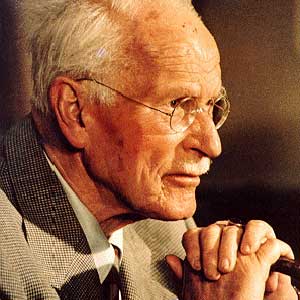
The Swiss psychoanalyst Carl Gustav Jung 1875 - 1961.
Carl Jung believed that personality can be divided into types, which he had in common with the ancient sages who believed that the twelve zodiac signs - arranged in four sets corresponding to the elements - define personality and destiny. The ancient Greeks also operated with four temperaments. Jung's type classification in his book "Psychologische Typen" from 1921 is also arranged in groups of four.
He believes that the most basic division is based on two "attitudes", introversion and extroversion. The word "attitude" in Jung's sense means something much deeper and more ingrained than the ordinary daily use of the word. He refers to it in several places as "natural", which indicates that he thought it was biologically determined, although he did not pay very much interest in this issue.
He himself invented the words extrovert and introvert, which stand for introverted and extroverted. He formed them from the Latin words "extra" and "intro", which means outside and inside, respectively, as well as "vertere", which means to turn.
In addition to the two "attitudes", Jung introduced four "functions", which are thinking, feeling, sensing and intuition. The "functions" are not grounded as deeply in the personality as the "attitudes", but very early - perhaps already in childhood - a person will get used to and perfect one of the four functions and to a greater or lesser degree displace the other three - a bit like a person very early on getting used to using either the right or left hand.
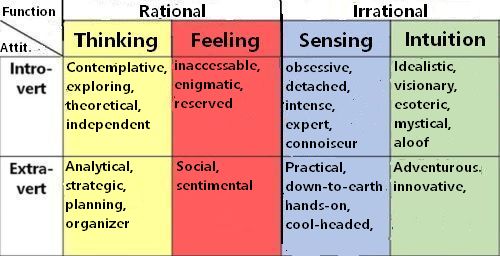
Jung's 8 combinations of personality types with some suggestions for typical personality traits, which one, however, should not consider as the only truth.
Jung's four functions are again subdivided into two pairs:
- Thinking
- Feeling
Which he calls "rational" functions and:
- Sensning
- Intuition
Which he calls "irrational" functions.
For Jung, it is the "psychic energy" that is the driving force that makes things happen. In early works, he used the term "libido", which we recognize from Freud as an extended sexual drive. Therefore, we can believe that Jung's "psychic energy" is Freud's libido, which has been further de-sexualized.
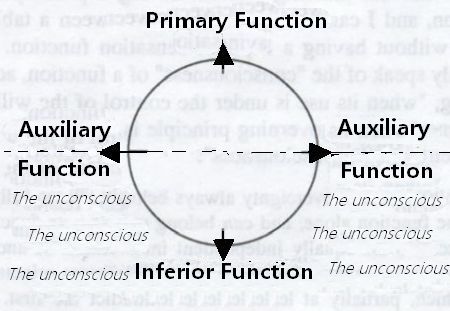
It is common to depict Jung's features as a kind of compass rose with arrows pointing towards the four corners of the world. We must imagine that inside the circle is the self, the subject, the ego - the unknown, which looks out of our eyes and listens with our ears. It hisses and bubbles with psychic energy, which wants to get out and experience the objects in the world outside the subject, to experience, gather information, assess and decide. The subject comes into contact with the objects of the reality by the psychic energy activating the functions.
The top primary function is the dominant and most used function. It gives name to the topical personality type. Jung writes that when - for example - the primary function is rational, then the second rational function must necessarily be effectively displaced as the inferior function, as the person will otherwise receive disturbing signals from the outside world. It leaves the irrational functions as auxiliary functions.
The same applies of course if the primary function is irrational, then the inferior function is also irrational and the rational functions are placed as auxiliary functions.
Here another of Jung's theories comes into play, namely his theory of the unconscious, which he no doubt has from his former mentor Sigmund Freud. The unconscious encompasses all the qualities desires, impulses and experiences that the person cannot accept and which are therefore excluded and displaced from his consciousness. The inferior function - and the auxiliary functions in part - are displaced into the unconscious. Photo Personality Types by Daryl Sharp.
It is absolutely inevitable that an individual will develop a - and only one - function as his preferred way of communicating with the objects of the external world. Jung writes: "Experience shows that due to unfavorable circumstances it is practically impossible for anyone in general to develop all his psychological functions at the same time. The demands of society force a man to use himself first and foremost on the differentiation of the function in which he is best, best equipped by nature, or which will ensure him the greatest social success. Very often, in fact, as a general rule, a man will identify himself more or less completely with the most favored and thus the most developed function. It is this that gives rise to the different psychological types."
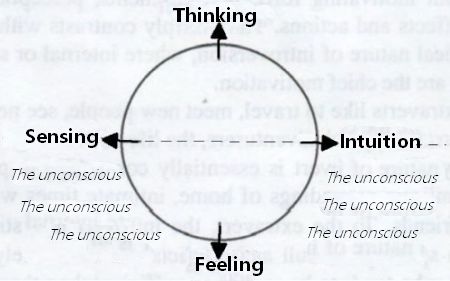
Let us assume that the primary function of a person is "thinking". Then the other rational function, "feeling", must be displaced deep into the unconscious and the auxiliary functions will then be "sensing" and "intuition".
The chart above shows 8 Jung personality types. For introvert and extrovert, respectively, the functions thinking, feeling, sensing and intuition can all be primary functions, giving 2x4 = 8 Jung personality types. However, even if the two help functions are partially repressed, they will not be equally important, one may be more developed than the other, and if one includes this relationship there will be 2x2x4 = 16 Jung personality types. But Jung himself did not put much emphasis on this last possibility. Photo Personality Types af Daryl Sharp.
"As a consequence of this one-sided development, one or more functions are necessarily delayed." For all functions are always present, even some are repressed into the unconscious. He continues: "They remain in a more or less primitive and infantile state, often only half conscious, or even quite unconscious. The relatively undeveloped functions constitute a specific inferiority which is characteristic of each type and is an integral part of his total character. The one-sided emphasis on thinking is always accompanied by an inferiority of feeling, and differentiated sensation is injurious to intuition and vice versa." By "differentiated" Jung meant "developed".
Therefore, if the primary function is rational, the second rational function will always be effectively displaced, and vice versa if it is irrational. Jung writes elsewhere: "But since it is a vital condition for the conscious process of adaptation always to have clear and unambiguous aims, the presence of a second
function of equal power is naturally ruled out." One might think that he meant that if two related functions are fighting for first place, a kind of interference will occur, which would be disruptive.
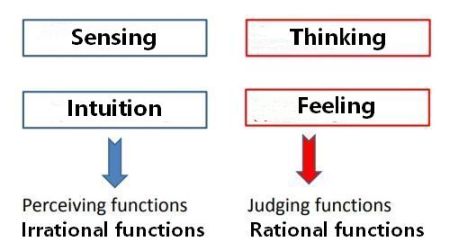
Jung described two of the four functions as irrational and the other two as rational. But sometimes he called the groups perceiving and judging, respectively. However, Isabel Myers took Jung's expression, Judging / Perceiving, and made into one of MBTI's personality scales alongside her three others. There is really nothing wrong with that, but it has created some confusion. Foto Wikipedia.
Jung's typology is not a test. There are no statements or questions to answer and there is no scoring system. Nor is it meant as a way of putting labels on the individual or put them into boxes. It is not his intention that type description should be the sole and final diagnosis for clients or other persons.
The typology is the essence of twenty years of experience, which should enable the therapist to identify the client's problem more safely and effectively. Jung writes: "This book is the fruit of nearly twenty years' work in the domain of practical psychology. It grew gradually in my thoughts, taking shape from the countless impressions and experiences of a psychiatrist in the treatment of nervous illnesses, from intercourse with men and women of all social levels, from my personal dealings with friend and foe alike, and, finally, from a critique of my own psychological peculiarities."
3. MBTI
Isabel Myers and her mother Katharine Briggs took as their starting point Carl Gustav Jung's two "attitudes" and four "functions", which are:
Attitude: E/I - Extrovert versus Introvert
- Which are outward and inward oriented.
In MBTI, the extroverts are generally better than the introverts. Unlike other traditional psychologists, they link extroversion with selfconfidence. The extroverts are extroverts because they have self-confidence. In much American literature, one can also get the impression that they consider introversion to be a mental problem that one must be cured of.
- Function: S/N - Sensing versus Intuition
By sensing is meant the information that we receive via our senses, ie sight, hearing and so on. The sensory-perceiving persons are such as the honest, pedantic accountant, the loyal and down-to-earth work-shap manager, or the eccentric technical specialist.
By intuition is meant gut feeling, inspiration, instinct, sensation, sixth sense and the like. The intuitively perceiving person are the born to be top managers who can naturally inspire their employees.
Function: T/F - Thinking versus Feeling
- By thinking is meant the information that we get by thinking in logical mathematical ways, such as "the sum of the angles in a triangle will always be 180 degrees" or "if all lions are predators" - "then the three specific lions in Odense Zoo are also predators" etc.
A person with a thinking decision-making manner is also described as result-oriented. Using logic, he has come to a conclusion about which decision is the objectively best, and he does not deviate from it. Countless job adds use the word results-oriented.
By feeling must be understood the information that we receive by examining our feelings, that is, what is a thing, person or solution worth to us, or whether it is important or not important. For example: We have received an offer to buy a house cheaply, but what is it worth to us, would we like to live there? A man or woman has declared his love for us, but what do our feelings say, do we love him or her?
The feeling type is the complete opposite of the thinking, an empathetic - but soft-hearted type - who is aware of other people's feelings.
In addition to these three Jung scales, Katharine Briggs and Isabel Myers added another parameter:
Lifestyle: J/P - Judging versus Perceiving
- Which in MBTI describes the person's preferred lifestyle. A Judging person prefers an organized planned lifestyle. He wants work out of the way brfore pleasure. Jung could have called it a rational lifestyle.
A perceiving personality prefers a "creative", messy lifestyle, he takes things as they come, he prefers pleasures prior to work and delivers all assignments at the last minute. It cannot be ruled out that some associate an element of arrogant superhuman in this lifestyle. Perhaps some famous artists and inventors have lived in this way.
4. Introversion
"Introversion", writes Jung, "is normally characterized by a
hesitant, reflective, retiring nature that keeps itself to itself,
shrinks from objects and is always slightly on the defensive."
Introverted personalities get more than extraverted their attitudes from their own independent observations of objective reality. They observe, read and think about things.
They may appear a little cold. They are reserved and do not easily show their feelings. They prefer to think before they say anything.
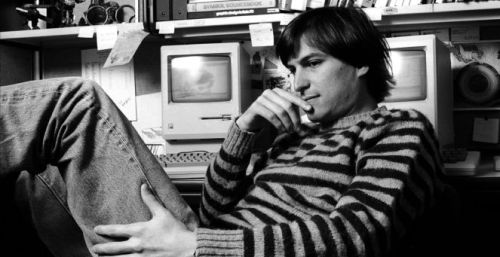
Steve Jobs as a young man. He was reportedly an INTJ type, that is, an introverted intuitive person. He communicated (when he was not speaking in public) in cold, precise terms, often cursing right in the faces of people without regard for their feelings. He did not believe in sugar coating, but preferred to use complete honesty in all his interactions. His main focus was whether things worked or not, and he did not care to analyze how they worked. When he was among his employees, he did not stop to ask how it looked like or to analyze the details. He asked "What should it do? And why does it not?" Steve Jobs was always extremely frustrated with inefficiency and fired people on the spot for not following the instructions precisely. In terms of lifestyle, he preferred simplicity and minimalism. Even as a millionaire, he lived in a simple house. Photo: The Book Addicts Guide to MBTI.
Introverted people want to look at the situation a little on the fringes of the assembly before they make themselves noticed. They present themselves modestly and do not constantly boast with their quick wittiness and strong personality. They are more the fascinated spectators to the social spectacle. They are happy to laugh in the right places and they are not afraid of being ignored.
Very introverted people find it exhausting to be with many people. Even a long phone call can make them tired.
Introverts are essentially conservative and prefer the familiar surroundings of the home. They feel most comfortable in small intimate groups of people they know well. Ideally, they will meet their close friends one at a time in confidential conversation.
Introverts may think that the extroverts are superficial and prone to the enjoyment of the present. The extroverts may find the introverts boring and predictable.
At Jung, the introverted woman has an extroverted "animus" - which is her ideal image of a man - that origins from her unconscious masculine personality traits.
5. Extraversion
Jung writes that extroverts "is normally characterized by an outgoing, candid, and accommodating nature that adapts easily to a given situation, quickly forms attachments, and, setting aside any possible misgivings, will often venture forth
with careless confidence into unknown situations." As a general rule, extroverts act first and think afterwards.
Extraverts like to travel, meet new people and see new places. They are open and friendly and typical adventurers. They may find introverts boring and predictable.
They are easy to get in touch with. They provide quick response to any question or approach. In MBTI, they are also warm-hearted persons.
The extroverts are self-conscious and spontaneously show their feelings. Jung writes: "He has no secrets he has not long since shared with others. Should something unmentionable nevertheless befall him, he prefers to forget it. Anything that might tarnish the parade of optimism and positivism is avoided. Whatever he thinks, intends, and does is displayed with conviction and warmth"

Extraverted personality types. Photo hr-portal.
Fully extroverted people are immensely social, they constantly want to be with a large group of people, preferably they must be fully visible in the center of events at all times. They have many different kinds of contacts that they cultivate with great energy, friends, girlfriends, acquaintances, neighbors and colleagues.
They love to take initiatives in large gatherings. They must make a name for themselves by asking questions, giving short speeches or telling jokes. They simply can not stand not being at the center of the congregation's attention.
Extroverted people mainly get their attitudes and their knowledge from others. They listen and discuss. Actual close contact with the basic matter is not their specialty. Ruling moral standards dictate their personal views. If the norms change, the extrovert adjusts his views and behavior patterns that necessarily must match. His capacity and propensity in adapting to existing external conditions is both his strength and his limitation.
Jung describes that the attitudes, thoughts, decisions, patterns of behavior, and religion of extroverts are not only influenced, but directly determined, by the dominant public attitudes: "Accordingly, the extravert's philosophy of life and his ethics are as a rule of a highly collective nature with a strong streak of altruism, and his conscience is in large measure dependent on public opinion - His religious convictions are determined, so to speak, by majority vote." Which explains why actors, singers and the like - who are always very extroverted people - are particularly ardent supporters of the prevailing climate religion, multiculturalism and LGBT enthusiasm.

Extravert personality-type. Photo cinejournal.
Jung explains further: "One man finds a piece of modem music beautiful because everybody else pretends it is beautiful. Another marries in order to please his parents but very much against his own interests. There are people who contrive to
make themselves ridiculous in order to amuse others - There are not a few who in everything they do or don't do have but one motive in mind: what will others think of
them?"
In MBTI, extraverts seem to be associated with self-awareness - they are extraverted because they are self-conscious. The extroverts are social initiators who set the mood and create contact between others.
The type of neurosis to which the extravert is most exposed is hysteria. His biggest fear is loneliness.
At Jung, the extraverted man has an introverted "anima" - which is his ideal image of a woman - that springs from his own unconscious feminine traits.
6. Sensning
Completely sensing personalities base their knowledge and attitudes on direct observations and concrete information that can be verified. They have deep mistrust of vague and uncertain information, which they tend to regard as wishful thinking and free imagination.
For the sensing personalities, direct observations are very important. They are deeply rooted in their own experiences or that of their closest colleagues. They will only reluctantly agree to generalize beyond direct experience.
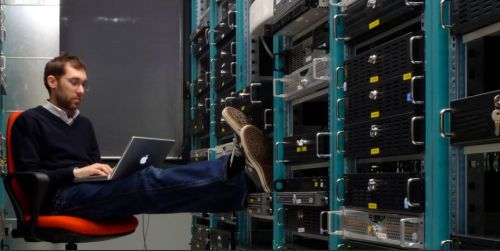
Sensing specialist. Photo Vitbich.
Sensing personalities are very practical. Their solutions are down-to-earth, well thought out and detailed, permeated by experience and common sense.
The sensing-minded personalities like practical work such as working with model cars, doing repairs in the house or handicrafts.
The sensing personalities are pragmatic. When presented with a new idea, they will ask: "OK, if it can really be done, what difference will it make, what can we gain?" They are not particularly interested in the new idea itself.
They are good observers. When they tell about something they have experienced, they can often remember a lot of details. Jung writes: "When someone enters the room, such a type notices how the person enters, the hair, the expression on the face, the clothes and the way the person walks - every detail becomes
absorbed."

Specialists at work. Photo Ohranatryda.
Sensing personality types trust everything that is familiar, they support familiar methods and traditional groupings.
Their love irrevocably depends on the physical attractions of the loved one.
Jung writes about the difference between a sensing and an intuitive type: "The difference between the two is equally striking when they enter an empty house. The sensation type sees the bare walls, the shabby window casements, the dirty floors. The intuitive sees rather what can be done with the space—the walls painted in soft pastels, pictures in place, sanded and shiny floors, clean windows and curtains, even where the furniture will go."
7. Intuition
In contrast to the sensing personality types, the intuitive personality type feel most comfortable manipulating the information already available. They compare data from different sources. They extract the essentials, abstract from less important information and create completely new theories. They read between the lines and they think they can pick up a lot of information from their sixth sense, their hunches and inspirations.

Intuitive personality type. Photo Informatica.
The Intuitive types like abstract theories. They find it tedious to deal with everyday practical problems.
Intuitive personalities like to come up with original, creative and alternative solutions - as opposed to the sensing ones, which are very practical. Even if the situation does not really require a new and different type of solution, they love the alternative.
They are intellectuals. They will love the logical structure of a new idea. They may insist on implementing it simply because it is different. They may argue that the new principle may create other benefits in the future in completely different areas.
The intuitive are theorists. Where the sensing types build on the direct experiences of their own or close colleagues', the intuitive types automatically search for new patterns in the present facts. They have no problem basing their decisions on a theory. They are inventive.
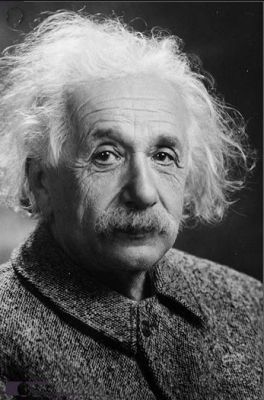
Einstein is said to have been an Intuitive INTP personality type. Photo Pinterest.
A sensing type looks at a house along with an intuitive one. The sensing sees only that which is before him. But the Intuitive sees the same scene transformed as in an inner vision, as if the house were already furnished and completely renovated. Therefore, the sensing type is recommended to bring an intuitive when looking at new house. Of course, the opposite is also true, because while the intuitive is spellbound of the possibilities, the sensing type notices if moisture seeps into the basement, the plumbing condition, the number of electrical outlets, the distance to the nearest school and so on.
Unlike the sensing types, who are good observers, intuitive types pay very little attention to what is going on in their immediate surroundings. They can completely ignore what is going on here and now.
Where the sensing types support familiar methods and traditional groupings, the Intuitive personality types, on the other hand, value initiative, ingenuity and new solutions. They often distrust conventional values.
8. Thinking
The thinking personality types go directly to their goals. They are results-oriented. They are determined and do not shy away from using force to overcome resistance. They are objective and reasoning in their daily decisions, clear-minded and impartial.
Such personality types process their knowledge using independent, objective and logical analysis. They divide their experience data into categories. They are not easily affected by the feelings of others. They evaluate without passion for and against in situations of choice.

Bill Gates is said to be a thinking ENTJ personality type. Foto Businessalligator.
Thinking personality types are intellectually independent. They do not compromise on the opinions they have formed on the basis of facts and logic. Once they have created a theory or an opinion, they can only be shaken from it by means of even better logic and new facts.
According to Jung, extreme extroverted thinking types subordinate both themselves and others to their "formula," a system of rules, ideals, and principles that eventually becomes a rigid moral codex. Their benchmarks are justice and truth, based on what they consider to be the purest conceivable formulation of objective reality. "Should" and "shall" are typical prominent aspects of their intellectual point of view. Those around them must, for the best of all, obey this "universal law."
But the thinking types do not have much idea of their emotions. Jung writes: "For instance, thinking types have no idea whether they have feeling or what kind of feeling it is. They have to sit half an hour and meditate as to whether they have feelings about something and, if so, what they are. If you ask a thinking type what he feels, he generally either replies with a thought or gives a quick conventional reaction; and if you then insist on knowing what he really feels, he does not know."
9. Feeling
In contrast to the thinking personality types, the feeling types are soft-hearted. They are tolerant of human errors. They try to take advantage of the positive in others and instinctively seek problem-solving solutions that are mutually beneficial.
Feeling personality types seek to win others over to their goals through persuasion. They do not like to use means of power. They tend to take human considerations into account in their decisions. They have a good sense of the feelings of others.

Mother Theresa at a hospice in Calcutta, India in 1969. She is said to have been a ISFJ feeling personality type.
The feeling personality types can adapt their own opinions to those of others. They seek harmony and want to please others. They are conflict-averse.
While the thinking type can only be convinced of a matter by means of facts and logic, the feeling personality types can be persuaded by the passion with which an opinion is put forward.
They are passionate in their day to day decisions. Feeling types do not have to think about what someone or something is worth to them, they just know. They base their decisions on general impressions, feelings and patterns. Personal sympathies and antipathies are important to them
Logical conclusions and thought processes that can lead to a disturbance of their feelings are rejected in advance."Everything that fits in with objective values," skriver Jung, "is good, and is loved, and everything else seems to -
exist in a world apart."
10. Judging
A personality type with an judging lifestyle would like to start on a task as soon as possible. He plans his efforts so that he can work on one problem at a time and finish according to his plan.
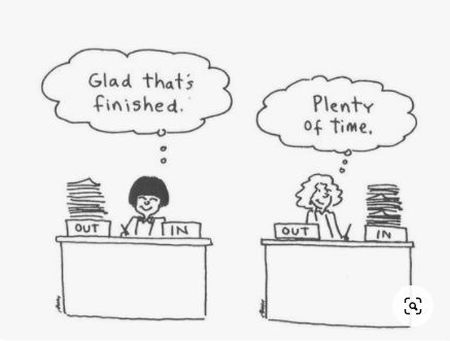
Judging versus perceiving personality type. Photo Pinterest - Semper Vita Institute.
Judging personality types want to work systematically. They prefer order and structure in their everyday lives. They value a common formal planning.
Personality types with an judging lifestyle like to set up standardized routines. They have no problem following the standard routines themselves.
Judging lifestyle types like to set long-term goals and set plans for far into the future. They use these goals and plans to structure their efforts.
11. Perceiving
Personality types with a perceiving lifestyle work best under pressure. They will postpone the threatening task for as long as possible, and when they get close to the deadline, they can work day and night. They prefer to work on many tasks at the same time, which they can alternate between.
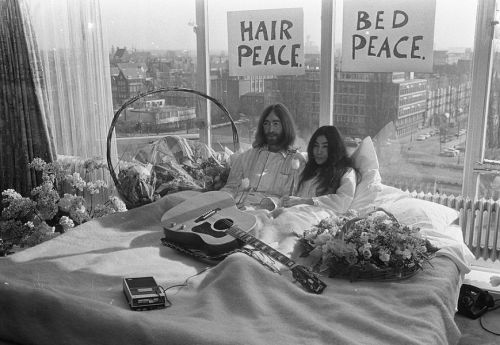
John Lennon and Yoko Ono in love-in for peace in the World at the Hilton Hotel in Amsterdam in 1969.
It has often been discussed - it is said - which personality type to attribute to John Lennon. There is doubt as to whether he was introverted or extraverted, INFP or ENFP. On the one hand, stage artists are most often extraverted, and on the other hand, many of his songs and poems reveal clear introverted features. There are many clear signs that he was intuitive and that he preferred to decide based on his feelings. One must also believe that only an perceiving lifestyle type (P) could think of holding love-in in a bed for several weeks for peace in the World, as he and Yoko Ono did in 1969 in Amsterdam and Montreal respectively. Photo Eric Koch Wikipedia.
Perceived lifestyle personalities are flexible and adapt to changing situations. In contrast to the judging types, they prefer informal guidelines for common formal planning.
They do not like to be bound by detailed long-term plans - not even by plans they set up themselves - that hinder their freedom and flexibility. They prefer to keep the options open for as long as possible.
Perceiving lifestyle types like spontaneity and they do not like to follow the same routines all the time. They seek variety and change.
People with a perceiving lifestyle make their plans along the way. They go into action without significant preparation or detailed plans. They are not afraid of risk.
12. 16 MBTI types
The 16 MBTI types are denoted by an abbreviation of four letters. Each letter is the first letter in the name of the basic types, except in intuition, which uses the abbreviation "N" since "I" are already used in Introvert. Judging and perceiving must necessarily be spelled in English to get the correct letters:
Attitude: Extravert versus Introvert.
Function: Sensning versus iNtuition.
Function: Thinkning versus Feeling.
Lifestyle: Judging versus Perceiving.
The MBTI type ISTJ will thus mean an introverted, sensing, thinking and judging personality. ENFP means an extravert, intuitive, feeling and perceiving personality.
MBTI follows in Jung's footsteps. He believed that the extrovert/introvert scale is the most important personality parameter, which he - and MBTI - calls "attitudes", which are more rooted in the personality than the following two scales, which he called "functions". MBTI divides the functions according to the most important scale, extrovert/introvert, then according to the next most important, sensing/intuition, and so on with the last one, the lifestyle scale.
But in any case, the most important thing for the system is the connection between a test result, which is expressed by one of the 16 combinations of letters such as ISTJ or ENFP, and the associated type descriptions, which should be true.
|
ISTJ
They are quiet and serious. Practical, realistic and responsible. Decide logically what should be done and work toward it steadily, regardless of distractions. They earn success by thoroughness and dependability and take pleasure in making everything orderly and organized - their work, their home, their life. They have value traditions and loyalty.
|
ISFJ
They are friendly, responsible, conscientious and quiet. they are committed to steadily meeting their obligations. Thorough, painstaking, and accurate, loyal, considerate. They notice and remember specifics about people who are important to them, and are concerned with how others feel. Strive to create an orderly and harmonious environment at work and at home.
|
INFJ
Conscientious and committed to their firm values. They want meaning and connection in ideas, relationships, and material possessions. They are insightful about others and want to understand what motivates people and are Develop a clear vision about how best to serve the common good. Organized and decisive in implementing their visions.
|
INTJ
They are skeptical and independent and have high standards of competence and performance - for themselves and others. Have original minds and great drive for implementing their ideas and achieving their goals. They quickly see patterns in external events and develop long-range explanatory perspectives. When committed, they organize a job and carry it through.
|
|
ISTP
They are quiet observers until a problem appears, then they act quickly to find workable solutions. Tolerant and flexible. They analyze what makes things work and readily get through large amounts of data to isolate the core of practical problems. Interested in cause and effect, organize facts using logical principles, value efficiency.
|
ISFP
They are kind quiet, sensitive and friendly. They enjoy the present moment and what is happening around them. They like to have their own space and to work within their own time frame. Loyal and committed to their values and to people who are important to them. Dislike disagreements and conflicts, do not force their opinions or values on others.
|
INFP
They are Curious, idealistic and quick to see possibilities, can be catalysts for implementing ideas. They are loyal to their values and to people who are important to them. Want an external life that is congruent with their values. Try to understand people and to help them fulfill their potential. Adaptable, flexible, and accepting unless a value is threatened.
|
INTP
They are theoretical and abstract-minded and seek to develop logical explanations for everything that interests them. They are interested more in ideas than in social interaction. Quiet, contained, flexible, and adaptable. Have unusual ability to focus in depth to solve problems in their area of interest. Skeptical, sometimes critical, always analytical.
|
|
ESTP
They take a pragmatic approach focused on immediate results and they are flexible and tolerant. Theories and conceptual explanations bore them - they want to act energetically to solve the problem. Focus on the present, spontaneous, enjoy each moment that they can be active with others. Enjoy material comforts and style. Learn best through doing.
|
ESFP
Very much lovers of life, people, and material comforts - outgoing, friendly, and accepting. Enjoy working with others to make things happen. They bring common sense and a realistic approach to their work, and make work fun. Flexible and spontaneous, adapt readily to new people and environments. Learn best by trying a new skill with other people.
|
ENFP
For them life is full of possibilities. They are warmly enthusiastic and imaginative. Make connections between events and information very quickly, and confidently proceed based on the patterns they see. Want a lot of affirmation from others, and readily give appreciation and support. Spontaneous and flexible, often rely on their ability to improvise and their verbal fluency.
|
ENTP
They are fast, ingenious, stimulating, alert, and outspoken. In solving new and challenging problems they are resourceful. Adept at generating conceptual possibilities and then analyzing them strategically. Good at reading other people. Bored by routine, will seldom do the same thing the same way, apt to turn to one new interest after another.
|
|
ESTJ
Persons of this type are realistic, down-to earth and practical. They are decisive and quickly move to implement decisions. Organize projects and people to get things done, focus on getting results in the most efficient way possible. Take care of routine details. Have a clear set of logical standards, systematically follow them and want others to also. Forceful in implementing their plans.
|
ESFJ
they want harmony and work with determination to establish it. They are warmhearted, conscientious, and cooperative. Like to work with others to complete tasks accurately and on time. Loyal, follow through even in small matters. Notice what others need in their day-by-day lives and try to provide it. Want to be appreciated for who they are and for what they contribute.
|
ENFJ
They are empathetic, responsive, and responsible. Highly aware of the emotions, needs, and motivations of others. Find potential in everyone, want to help others fulfill their potential. May act as catalysts for individual and group growth. Loyal, responsive to praise and criticism. Sociable, facilitate others in a group, and provide inspiring leadership.
|
ENTJ
They are decisive and direct, assume leadership readily. Quickly see illogical and inefficient procedures and policies, develop and implement comprehensive systems to solve organizational problems. Enjoy long-term planning and goal setting. Usually well informed, well read, enjoy expanding their knowledge and passing it on to others. They are forceful in presenting their ideas.
|
The 16 MBTI Types - Review of introduction to types.
13. Typical Questions
The current European version of MBTI contains 88 coercive questions, which means that a test-taker must choose one of two possible answers to each statement. They are a mixture of word pairs and short statements. Test takers may skip questions if they feel they are unable to choose.
Statement |
Scoring |
|
I often get new energy and new thoughts when I am with others.
I get best new energy and new thoughts from being with myself, for example when I read a book.
|
E/I
|
|
Others often perceive me as a thoughtful person.
Others often perceive me as a spontaneous person.
|
E/I
|
|
I like to go into details.
I prefer to stick to an overall plan.
|
S/N
|
|
When I have to make decisions, I often base them on a logical, objective analysis.
When I have to make decisions, I often base them on personal views and attitudes.
|
T/F
|
|
I am usually not so easily affected by other people's state of mind.
I am usually easily affected by other people's state of mind.
|
T/F
|
|
I work best and most efficiently under pressure, and when I have to do several tasks at the same time.
I work best and most efficiently when I can plan and solve the tasks at my own pace, one at a time.
|
J/P
|
|
I often prefer to communicate face to face.
I often prefer written communication.
|
E/I
|
|
I may well interrupt others during a discussion.
I usually always let others finish before I say anything.
|
E/I
|
|
I often base my decision on the consequences for other people.
I often base my decision on principles, criteria and logic.
|
T/F
|
|
I usually always arrive before the agreed time.
I usually arrive on time or a little later than the agreed time.
|
J/P
|
|
I often need to think things over before I speak.
I often need to talk about things before I can think them through.
|
E/I
|
|
When I have to learn something new, I prefer to understand the individual sub-elements first before putting them together into a whole.
When I have to learn something new, I prefer to understand the whole first before I get into the individual sub-elements.
|
S/N
|
|
I often make schedules and write lists as a basis for my actions.
I write lists and yellow notes to do something about it later (maybe).
|
J/P
|
|
When I explain something, I often refer to concrete examples.
When I explain something, I often refer to general concepts.
|
S/N
|
|
When I have to do an assignment, I usually start at the last minute, and often finish it first, the night before it has to be handed in.
When I have to do an assignment, I usually start well in advance and read it along the way so that it is completed in good time before it has to be handed in.
|
J/P
|
|
In large gatherings, I prefer to speak only when asked.
In large gatherings, I often express my opinion or ask questions.
|
E/I
|
|
I take it most as it comes.
I appreciate order and clarity.
|
J/P
|
|
I often assess things on the basis of what can actually be done
I often come up with original suggestions with more abstract ideas.
|
S/N
|
|
I often attack my tasks in an untraditional way.
I base my problem solving on facts.
|
S/N
|
Typical questions in MBTI. As can be seen, there are no subtle in-depth psychological issues. Everything is very simple and transparent. Apparently, the test is very much dependent on the test taker's honesty and that he or she is really interested in getting a bid on his og her personality type.
14. Leader Versus Case Manager
We are often told that managers and specialists, caseworkers, salespeople and technicians are all equal. They perform various functions, but none are superior to the others.
That is a beautiful thought, but it is not true. Men rival to achieve status and fortune to achieve women's love. Ambitious women want to surpass men in their careers. It cannot be denied that a manager enjoys a higher status than a caseworker.
Distribution of MBTI types in the United States. The largest group is ISFJ with 13.8% - although with considerable uncertainty - the smallest group is ENTJ.
The Myers & Briggs Foundation describes ISFJ personalities as: "Quiet, kind, responsible and conscientious. Committed and constant in fulfilling their obligations. Thorough, careful and accurate. Loyal, considerate."
And ENTJ personalities are described as: "Straightforward, determined, takes easily leadership. Quickly sees illogical and inefficient procedures and policies, develops and implements comprehensive systems."
It is the task of the leaders to achieve the goals of the organization using the resources at his disposal, including his subordinates, the employees. To achieve his goals, he manipulates his caseworkers and technicians, in the same way that a chess player moves around his pieces to win. It is obvious that a Manager is more than one of his employees.
Today, one must be a leader in order to have the opportunity for a real career, that is, a real social ascent.
If you prefer a working life as a specialist or caseworker, you can also have a good life. It is really true that money is not everything. Specialists and caseworkers do not have the same status as managers. But they can hope to get a decent salary and a regular life.
15. Self-improvement
The big question is whether personality is innate and thus unchangeable or whether it is learned through growing up and influenced by life experiences and thus possibly changeable. "Nature or nurture", as it was formulated around 1900 by Darwin's half-cousin, Francis Galton. Is personality immutable from birth to death, or can the individual consciously adapt his personality - or perhaps parts of it - to the challenges of life?
The prevailing politically correct view is without doubt that upbringing are all-important for the forming of intelligence and personality. The general opinion is - for example - that women and men from birth are similar except for some minor physical differences. It is believed that Africans, Arabs and Europeans are in fact identical except for skin and hair color, and the difference we experience is due to the unhappy upbringing of women and Africans with sexism, racism, discrimination and oppression.

Identical twins. Foto Ok.ru.
But modern studies of twins, who are believed to be genetically similar, and who have been separated from birth and have not seen each other since, have revealed astonishing similarities in their habits, interests and entire course of life, which must be due to their similar genes. Differences have also been identified which may be thought to be due to the fact that they grew up in different families and different environments.
Most psychologists do not take a stand on this issue - if personality is innate, partly innate or not at all. They simply take their starting point based on the individual people they meet in their lives or in their clinic.
Only Eisenck is more specific. He supported the American psychologist Arthur Jensen's theory that intelligence is hereditary and that the difference between black and white Americans' results in IQ tests was caused by genetic differences that could not be offset by teaching.
He studied the behavior of infants and showed that from birth there are clear differences from child to child in terms of, for example, irritability, pace, sociability, anxiety, tendency to cry and much more. Which clearly indicate that personality is largely innate. He believed that the difference between Extraverts and Introverts is due to congenital conditions in the brain. Neuroticism is due to congenital conditions in the sympathetic nervous system and psychoticism can be attributed to congenital high levels of, among other things, the hormone testosterone.
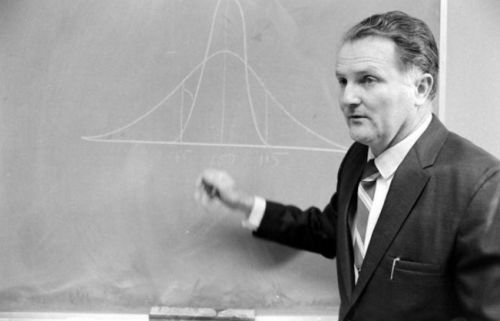
The American psychologist Arthur Jensen argued for continued racial segregation in the American education system and therefore he was condemned as a racist by researchers and civil rights activists in the late 1960's. However, Jensen himself believed that he had been misunderstood. Photo artsandculture.google.com
This is why we can fear personality tests. We may fear that by mistake or misunderstanding we will give some unfortunate responses which do not really describe us, and if personality is immutable, we will thereby be put in the wrong box for life.
However - even Eysenck admits that large parts of the personality are learned, which probably opens up the possibility of changes, improvements, or at least adjustments. And this is precisely the intention of the MBTI test designers.
One can try to analyze one's own behavior. For example: Why I did not speak at a recent meeting, even though I had a completely relevant and important message. I came to the meeting decided to take the floor, but when it came down to it, I turned it down and thought it was probably not that important. In what situations did I leave with a vague feeling that I could have done better, while at the same time devising various excuses for myself. Why did I get so drunk the other day and made myself a little laughable? Why could I not just loosen up and make some fun at the birthday the other day, like many others did? How did I function in this and that situation, or with this and that persons? What came out of it? Why did I mess things up after delivering a very clear message at the meeting the other day?
Self-knowledge - and thus the possibility of self-improvement - can be made even more analytical by incorporating Jung's functions and MBTI's parameters. Why can I not pull myself together to study when I am alone? Was I too dominant at this and that meeting (Extravert versus Introvert) or did I allow it to degenerate into a lot of superfluous talking? Should I have given more room to the others? Have we included everything in this and that project (Sensing versus Intuition) or was I too inclined to push a decision? Why did I not immediately take the consequence after some serious mistakes appeared? (Thinking versus Feeling). What does this say about my psychology? What can I do about it? What do I want to do about it?
It is something like this that MBTI can be used for. It is not a tool for in-depth psychological revelation.
16. Literature
20201009




















